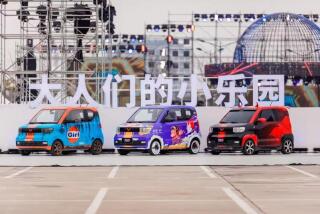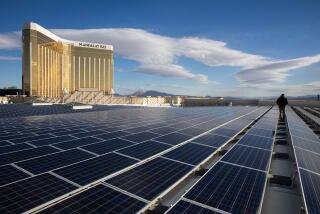China, green? In the case of water heaters, yes
RIZHAO, CHINA — Before her family bought a solar water heater, Liu Yan would bathe the way many working-class Chinese have for generations: boil water, dampen a rag and wipe away the dirt.
Today, the 40-year-old mother and her family shower every day and wash their dishes with hot water. The stainless steel heater affixed to her red-tiled roof cost about $220.
The device has become a symbol of China’s rising standard of living and its leap into the era of clean energy.
In the seaside city of 2.8 million where Liu lives in Shandong province, 99% of households use solar water heaters. The mattress-sized contraptions dominate Rizhao’s skyline, resting haphazardly on almost every residential rooftop.
In the global race to develop green technology and stem climate change, China has quickly become a leading producer of solar panels and wind turbines. It also dominates the lesser-known technology of solar water heaters.
Using principles of solar heating more than a century old, the humble, low-cost devices consist of an angled row of cola-colored glass tubes that absorb heat from the sun. The most common models fill the tubes with cold water. As it heats, the water rises into an insulated tank where it can remain hot for days.
The devices have improved so much over the years that some don’t need direct sunlight -- all the more valuable in China’s often hazy and smoggy cities. Newer models have electrical heaters inside the water tanks that switch on if the water gets too cold on frigid days.
Popular in some parts of the United States around the turn of the 20th century before being made obsolete by cheap natural gas, solar heaters are now hailed as one of China’s greatest environmental success stories. More than 30 million homes have the devices, accounting for two-thirds of the world’s solar water heating energy.
Manufacturers are eyeing foreign markets, including customers in Southern California.
“China absolutely dominates the global market and they’ve done it relatively quietly and without a lot of fanfare,” said Christopher Flavin, president of the Washington-based Worldwatch Institute. “It’s an interesting example of their ability to take technology that was developed elsewhere and adapt it to their market on a scale no one had conceived of.”
The widespread development of solar heaters in China can appear paradoxical in a country that leads the world in carbon dioxide emissions and where two-thirds of the rivers and lakes are contaminated.
Such is the nature of China’s push to tackle climate change. In this rapidly developing economy, some of the nation’s biggest polluters reside alongside the biggest renewable energy projects.
Scenes like Rizhao’s crowded, energy-efficient rooftops are repeated all over China, often in the shadows of carbon spewing smokestacks and noxious chemical plants. Rizhao is one of a small but growing number of Chinese cities requiring solar heaters to be installed or subsidized.
“There are two different stories in China,” said Barbara Finamore, director of the National Resources Defense Council’s China Program. “There’s dramatic progress. There’s no denying that. At the same time, they’re still building, on average, a new coal-fired [power] plant every week.”
The heating of water accounts for a quarter of a typical building’s energy usage. The Chinese solar heaters are estimated to have prevented more than 20 million tons of carbon dioxide that would have been emitted annually using electrical units.
The heaters will be much needed if Beijing is to meet its goal of reducing its reliance on coal, which supplies 80% of the country’s energy. The central government aims to meet 15% of its energy needs through renewable sources by 2020. Beijing hopes to triple its solar heater capacity by the same year, according to Greenpeace China.
The technology’s gains here lie in its affordability, the dearth of residential natural gas service and the modest expectations of consumers, many of whom had never enjoyed hot water at home before. The starting price for one of the clunky devices is around $220, about the same as an electric heater in China. In the United States, where labor costs are higher and systems tend to be larger and more elaborate, solar water heaters can easily cost $1,500 or more.
“The key to the success in China is that the low price enables people to have an instantaneous payback,” said John Perlin, a solar energy historian and author of “From Space to Earth: The Story of Solar Electricity.”
A thriving, hyper-competitive industry of 5,000 manufacturers has grown up in the last decade or more, driving costs down and widening the range of quality.
“The market is huge, but the competition is fearsome,” said Bi Bangquan, president of Ri- zhao Gold Giant Solar Power, one of 150 manufacturers based in the city.
To find new customers, he’s turned to rural areas. That can mean sending sales teams to villages, where stages are erected for singing and dancing performers to promote the virtues of his solar heaters.
Each manufacturer touts its product’s ability to heat water within hours and insulate that heat for days.
“I guarantee my water’s hot enough to take the feathers off a chicken,” said one of Bi’s rivals, Zhang Shouqin, founder of Rizhao Qin Naier Solar Power.
Some Chinese companies hoping to boost sales are looking to other countries, including the United States. Only about 1% of the world’s solar water heating energy is produced in the U.S., but climate change is spurring interest in the technology. The California Public Utilities Commission has recommended the establishment of a $300-million incentive program to encourage homeowners to install units.
Bi dreams of exporting, but he’s concerned that his heaters would be no match for Western habits. A typical American uses 100 gallons of water daily, both hot and cold, according to the U.S. Environmental Protection Agency. In China, an urban resident uses half that, and a rural dweller about a fifth.
Many of the older or cheaper Chinese models are far from perfect, lacking auxiliary heating elements to warm the water on cloudy days.
“I have to look outside and make sure it’s been sunny before I decide to take a shower,” said a 53-year-old retiree in Rizhao who gave only his surname, Xiao. “Otherwise you’ll get a cold surprise.”
About 225 miles northwest of Rizhao is the headquarters of Himin Solar Energy Group, China’s largest and most advanced solar water heater maker, which recently garnered a $50-million investment from Goldman Sachs.
Himin’s influence runs deep in its hometown, Dezhou. The streets of the city of 5.5 million are illuminated with solar-powered lights; 90% of its households have solar water heaters.
Company founder Huang Ming is building an expansive residential development in Dezhou called Utopia Garden to showcase the potential of solar technology. Scheduled for completion in 2013, the row of high-rise buildings will be crowned with a ribbon of solar thermal tubing and photovoltaic panels that will supply much of the complex’s energy needs.
“We’re only at the bottom of a big mountain,” Huang said. Solar “can push a change in lifestyle.”
--
Nicole Liu in The Times’ Beijing Bureau contributed to this report.
More to Read
Inside the business of entertainment
The Wide Shot brings you news, analysis and insights on everything from streaming wars to production — and what it all means for the future.
You may occasionally receive promotional content from the Los Angeles Times.











